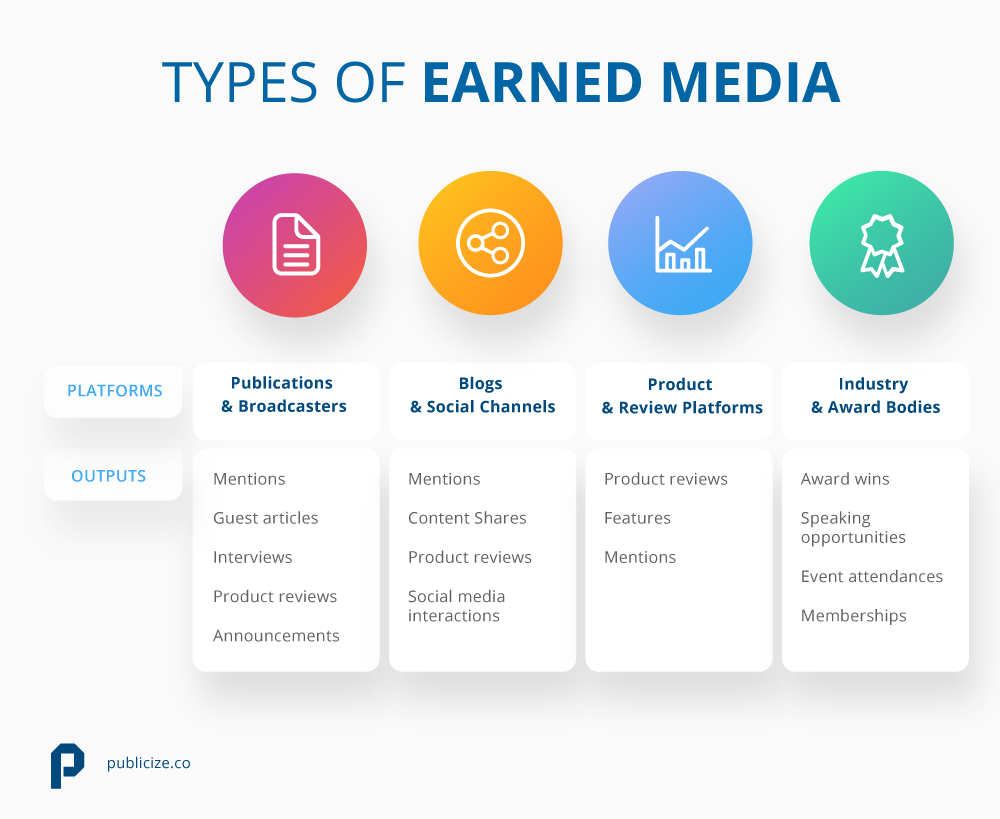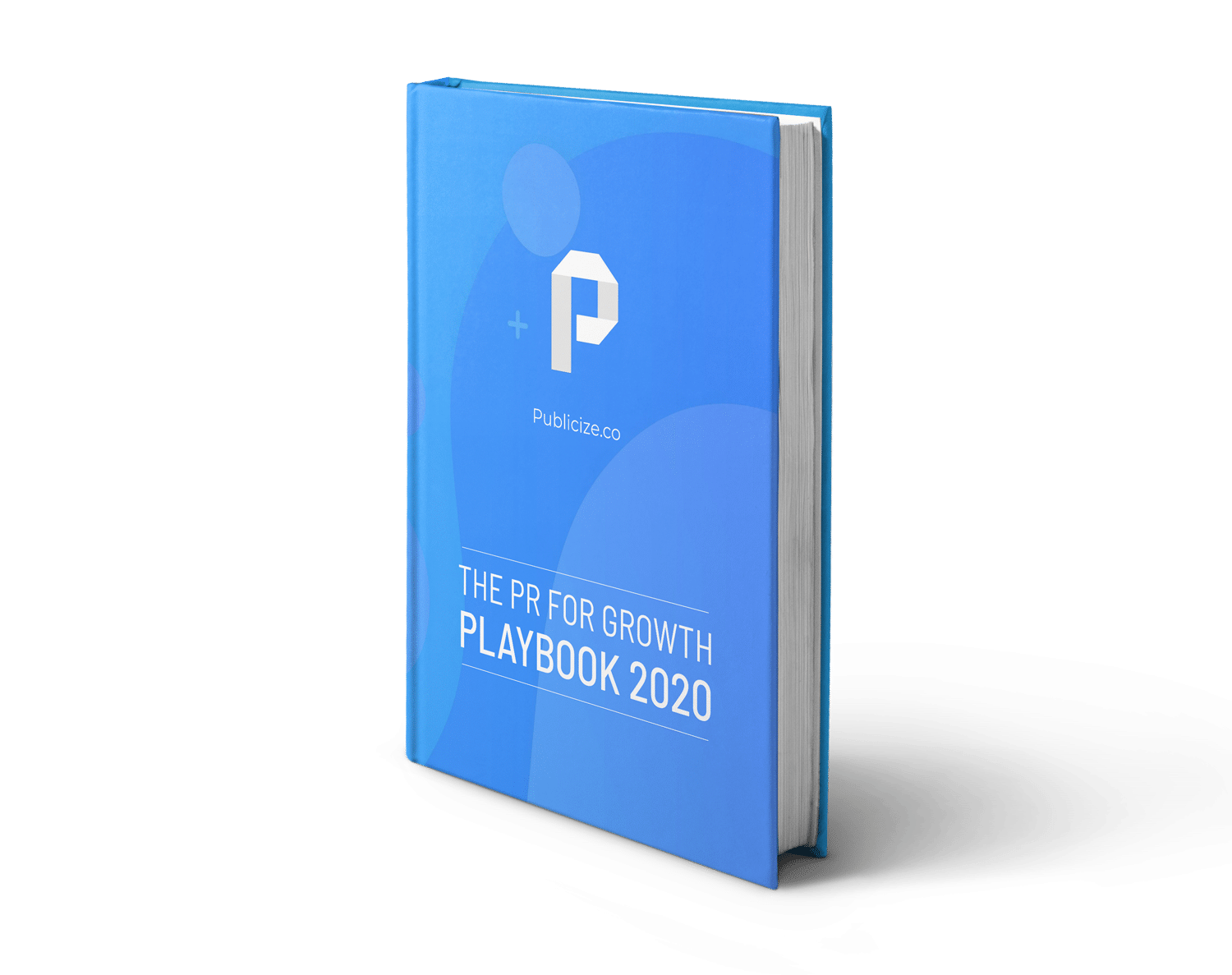Effective content strategies don’t rely on one single tactic. Generating qualified leads demands that you frequently craft and publish valuable content, and to come up with a strategy for promoting it.
Under the umbrella of PR, there are different types of media that get traditionally involved in the process of establishing the best strategy:
- Paid media
- Earned media
- Shared media
- Owned media
When it comes to PR, the real measure of return of investment are earned media wins. With this being said, we’re going to dive deeper into earned media and determine why it’s so effective at making businesses stand out from the crowd.
In this article, we‘ll cover:
–What Is Earned Media?
–Types of Earned Media
-Why is Earned Media important?
-Earned Media vs Paid Media
-Best Earned Media Practises
-Earned Media Attribution
-Earned Media Disadvantages
Let’s kick things off with a definition of earned media.
What is Earned Media?
In a nutshell, earned media is any piece of unpaid publicity about your business. Earned media is produced and published externally to your own marketing channels.
Earned media through PR has no direct cost, although sustained time and effort is required in order to build media relationships and to produce content and material.
Types of Earned Media
As you can see, within the PR Landscape, earned media means any channel or medium of influence that has some form of editorial control.
But what are the different types of earned media?
Here’s a brief list of tangible earned media achievements:
- Getting your name in print
- Having a major publication write about your startup or company
- Appearing on prime time news to talk about your products or services
- Having your product or service reviewed in an industry-specific publication
- Writing a guest article for a top-tier publication
- Being interviewed about your company on a podcast, radio or TV show
And if these aren’t enough, here’s a handy infographic showing the different types of earned media tactics by channel:
Why is Earned Media Important?
Earned Media plays a pivotal role when it comes to securing the prosperity of your lead generation efforts.
SEO benefits of winning earned media are undeniable. If you want your site on page one of Google for popular search terms, you have to build up your backlink profile. Google’s link scheme guidance makes it crystal clear that the more nefarious link building schemes of yesteryear are no longer acceptable.
What does this mean?
That sites have to earn natural backlinks for them to be given any weighting by Google. Also, backlinks won via earned media are increasingly being seen as one of the best forms of link building within the SEO community.
According to a survey, almost 40% of U.S adults have installed ad-blockers on their computers, making it harder for advertisers to reach potential customers. Such a scenario raises the question:
What can brands do to properly connect with their audiences and consumers if traditional ways such as online ads are less effective?
The solution, as described in the first paragraph, is combining different types of media.
Generally speaking, audiences trust when a well-respected journalist, blogger or influencer directly addresses a brand. This single piece of earned media has the potential to reach a much wider audience and potential new customer segments unknown to the brand..
The most important takeaway?
Digital ads cannot compete with such a tremendous level of trust.
Earned Media vs Paid Media
For a startup or any other business to succeed, their target consumers need to be aware of them. But more than that, they need to be seen as credible.
Businesses can’t buy credibility via paid media.
Online ads and PPC campaigns will certainly raise awareness about your startup or company and drive traffic to your website, but as soon as you stop paying for those services they disappear, and conversion will be difficult to achieve without the trust and credibility of the platforms and the outputs shown in the infographic above.
In fact, research shows us time and again that consumers and the public trust earned media way, way more than paid media. A Nielsen survey (from a couple of years back) reports that 92% of consumers say they trust earned media, while only half trust paid media.
And if your product hasn’t yet hit the market as you’re looking for funding, paid media can’t be utilized to drive awareness or credibility. In this instance, earned media is the only effective means of doing this.
To leverage earned media to boost your company’s growth, take a look at our PR for Growth Playbook.
Best Earned Media Practices
Convinced about the value of earned media but unsure of the best approach?
Step one is to create a comprehensive earned media strategy that aligns with your business goals. To do this, here are some best practices on how to win earned media and how to get media coverage for your business to get the ball rolling.
1. Create valuable content
Producing high quality content for your target audience will increase your credibility and help you become a thought leader in your industry. In addition, content that’s valuable to your target audience has a good chance of being shared through social media.
2. Target relevant publications and journalists
An effective earned media strategy is all about understanding who your audience is. Once you’ve determined what your audience is searching for, and your target publications, start investing your time in building relationships with journalists before sending your pitch. A personal touch and pre-existing connection will set you apart hundreds of pitches that journalists receive daily.
3. Leverage social media
Social media is the perfect vehicle for refining your brand’s message, and amplifying your owned media exposure. A great example of this is GoPro, a company that has used social media to enhance their brand and create a community with millions of dedicated customers around their owned content.
4. Use the right tools
It’s not uncommon to find businesses who don’t use digital resources to bolster their earned media efforts. Believe me when I say, however, that there are a whole host of great tools which are both free and effective at getting your business media coverage.
–HARO: HARO (Help a Reporter Out) is a tool that journalists use to find experts for their stories. By making yourself a source on HARO, connecting with the right journalists is made easy. Many businesses use HARO as a tool for fostering thought leadership and building their professional network. For more info on how to use HARO, check out our handy blog here.HARO is predominantly used for US-based queries and sources.
–SOURCEBOTTLE: SOURCEBOTTLE is similar to HARO but also services the UK and Australian markets. It also allows small, independent media such as bloggers to seek expert quotes and guest blog writers. So, if you only want to seek publicity in established media outlets, it’s better to stick with HARO.
5. Create excellent customer experiences
In the era where people decide where to eat based on Yelp and Google reviews, it’s important to provide great service to your customers. Excellent reviews from current and former clients is arguably more powerful than a mention from any media outlet.
Earned Media Attribution
Interestingly, earned media has not been used to its full extent simply because companies think that measuring its real ROI is somewhat complicated. Fortunately, that’s no longer the case.
Tracking your website referrals and media mentions make monitoring your results and measuring your earned media wins easy. Tools like Google Analytics will give you free insights to your referrals, and Google Media Alerts will let you know every time your company is mentioned online.
Share of Voice (SOV), which compares your media mentions to your competitors and the quality of those mentions can equally be useful for acquiring earned media insights. Calculating SOV can be a dreary task to complete manually. Luckily, there are useful platforms such as Glean, Brandwatch and Talkwalker that can take that weight off your shoulders and provide useful metrics of your earned media results.
Earned Media Disadvantages
The advantages of earned media such as building credibility, consumer trust, brand awareness and lead generation have already been addressed.
What are the downsides of earned media?
Of course, we can’t claim that earned media has zero negative aspects.
For example, professional and consumer reviews can be negative as well as positive, and no company is immune from a PR crisis. You have to accept that you’re relinquishing control with earned media. A journalist may miss the narrative you were trying to hit, or your pitch may not be picked up at all.
Despite the risk, the rewards of executing a solid earned media strategy are there for all to see and can be the game-changer for your company’s success.







